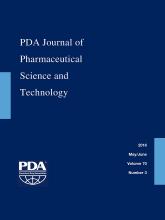Abstract
The majority of parenteral drug products are manufactured in glass vials with an elastomeric rubber stopper and a crimp cap. The vial sealing process is a critical process step during fill-and-finish operations, as it defines the seal quality of the final product. Different critical capping process parameters can affect rubber stopper defects, rubber stopper compression, container closure integrity, and also crimp cap quality. A sufficiently high force to remove the flip-off button prior to usage is required to ensure quality of the drug product unit by the flip-off button during storage, transportation, and until opening and use. Therefore, the final product is 100% visually inspected for lose or defective crimp caps, which is subjective as well as time- and labor-intensive. In this study, we sealed several container closure system configurations with different capping equipment settings (with corresponding residual seal force values) to investigate the torque moment required to turn the crimp cap. A correlation between torque moment and residual seal force has been established. The torque moment was found to be influenced by several parameters, including diameter of the vial head, type of rubber stopper (serum or lyophilized) and type of crimp cap (West® or Datwyler®). In addition, we measured the force required to remove the flip-off button of a sealed container closure system. The capping process had no influence on measured forces; however, it was possible to detect partially crimped vials. In conclusion, a controlled capping process with a defined target residual seal force range leads to a tight crimp cap on a sealed container closure system and can ensure product quality.
LAY ABSTRACT: The majority of parenteral drug products are manufactured in a glass vials with an elastomeric rubber stopper and a crimp cap. The vial sealing process is a critical process step during fill-and-finish operations, as it defines the seal quality of the final product. An adequate force to remove the flip-off button prior to usage is required to ensure product quality during storage and transportation until use. In addition, the complete crimp cap needs to be fixed in a tight position on the vial. In this study, we investigated the torque moment required to turn the crimp cap and the force required to remove the flip-off button of container closure system sealed with different capping equipment process parameters (having different residual seal force values).
- Residual seal force (RSF)
- Container closure system (CCS)
- Capping
- Crimping
- Crimp cap
- Flip-off removal
- Torque moment
- Process control
- © PDA, Inc. 2016
PDA members receive access to all articles published in the current year and previous volume year. Institutional subscribers received access to all content. Log in below to receive access to this article if you are either of these.
If you are neither or you are a PDA member trying to access an article outside of your membership license, then you must purchase access to this article (below). If you do not have a username or password for JPST, you will be required to create an account prior to purchasing.
Full issue PDFs are for PDA members only.
Note to pda.org users
The PDA and PDA bookstore websites (www.pda.org and www.pda.org/bookstore) are separate websites from the PDA JPST website. When you first join PDA, your initial UserID and Password are sent to HighWirePress to create your PDA JPST account. Subsequent UserrID and Password changes required at the PDA websites will not pass on to PDA JPST and vice versa. If you forget your PDA JPST UserID and/or Password, you can request help to retrieve UserID and reset Password below.






